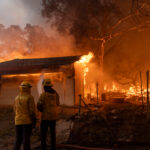South Carolina Gov. Mark Sanford repeated calls last week for state and local officials, not the federal government, to retain control during hurricane response efforts.
The Republican governor said the lack of preparation for Hurricane Katrina in New Orleans in 2005 and the criticism of the federal government that followed upended hundreds of years of tradition regarding who should make decisions.
“There is a big philosophical divide in emergency response,” Sanford said during a hurricane preparedness meeting with state officials. “Katrina set in motion the possibility of completely turning upside down the federal model.”
To avoid that, the state must get it right should a hurricane hit, he said.
And, Sanford said, “South Carolina is more than due for a major hurricane on the East Coast.”
Hurricane season officially begins June 1. National Weather Service forecasters said last week they expect 13 to 17 tropical storms, with seven to 10 of them becoming hurricanes and three to five of them in the strong category.
While the federal government can provide money and support, Sanford said it makes no sense for people from outside the state, who don’t know the geography, to be making decisions.
For example, Sanford said, he has homes along South Carolina’s coast and knows local routes and buildings well. But to military troops from another state, South Carolina might as well be a foreign country, he said.
What always worked before, Sanford said, was for “people who have local knowledge of local resources to be in control. It would be crazy for that model to be turned upside down.”
While the state is ready for a hurricane, residents must make personal response plans, too, Sanford said. He fears South Carolinians have become complacent in the last few years without a major hurricane.
“Murphy’s Law always exists in the world of storms,” he said. “Storms are not just about loss of stuff but about losing lives. I encourage folks to remember the images they saw in (Hurricane) Katrina.”
He encouraged residents to pack up and leave before emergency evacuation orders, because by that time, traffic will move slowly. At best predictions, vehicles will be moving at 35 mph to 45 mph, he said.
Within a couple days of predicted landfall, about 2,200 soldiers would be at armories, ready to respond, said Brig. Gen. Les Eisner of the South Carolina Army National Guard. The deployment of roughly 1,600 of South Carolina’s soldiers overseas will not hurt the state’s emergency preparedness, Eisner said.
There are plans for lane reversals along the South Carolina coast to evacuate people as swiftly as possible. Along U.S. Highway 278 in Beaufort County, lanes will be reversed all the way to Interstate 95, said James Schweitzer, director of the Department of Public Safety.
A mandatory evacuation in 1999 for Hurricane Floyd turned into a traffic nightmare along Interstate 26, as north-bound lanes turned into a giant parking lot.
The Transportation Department has installed more cameras along evacuation routes, and people can check traffic flow on the agency’s Web site, said Tony Chapman, a state engineer.
Preparations for evacuating nursing homes and hospitals will start about five days before a hurricane is predicted to hit, which is earlier than in previous years, said Earl Hunter, commissioner of the state Department of Health and Environmental Control.
There are 236 shelters available, an increase of two over last year, and several thousand employees trained to staff them, said Kathleen Hayes, director of the Department of Social Services.
Also this year, the state has more emergency radios and satellite phones, and more generators for shelters, agency officials said.
___
On the Net:
DOT traffic cameras: http://www.dot.state.sc.us/getting/cams
Was this article valuable?
Here are more articles you may enjoy.

 Edison Sues LA County Over Fire Deaths for Delayed Alerts
Edison Sues LA County Over Fire Deaths for Delayed Alerts  First Brands Judge Approves Examiner to Probe Fraud Allegations
First Brands Judge Approves Examiner to Probe Fraud Allegations  Allianz Built An AI Agent to Train Claims Professionals in Virtual Reality
Allianz Built An AI Agent to Train Claims Professionals in Virtual Reality  LA Fire Survivors Got a Rude Surprise That Could Hit More Americans
LA Fire Survivors Got a Rude Surprise That Could Hit More Americans 